Bamidele Famoofo
Nigeria’s quest to increase its debt burden by $26 billion amid fiscal fragility is seen as a threat to growth.
“Amid a fast-rising debt profile, the government appears to be treading a precarious path—one that may keep the country perched on a fiscal cliff,” analysts warned.
Recently, President Bola Tinubu submitted a fresh request to the National Assembly, seeking approval for over $21.5 billion in external loans as part of the government’s 2025–2026 Borrowing Plan. This request is intended to plug financing gaps and support economic growth ambitions. Alongside the $21.5
billion plan, the government is also pursuing additional borrowings amounting to €2.2 billion (approximately $2.5 billion) and 15 billion yen (about $103.97 million) from foreign sources, as well as $2 billion in naira-denominated debt from the domestic market.
In total, these new borrowings are expected to account for
roughly 60 percent of the total spending outlined in the proposed 2025 budget, signaling a shift in strategy.
While the government had previously highlighted its intention to shift towards foreign direct investments (FDI) and attract equity investors in order to reduce reliance on debt, the latest borrowing plans appear to contrast sharply with that narrative—raising the cost of borrowing and placing increased pressure on fiscal stability.
According to official disclosures, the borrowing plan targets strategic sectors such as infrastructure, agriculture, health, education, water supply, security, financial and monetary reforms, as well as job creation and growth support.
The proposed borrowing strategy is embedded within the broader Medium-Term Expenditure Framework (MTEF), in accordance with the Fiscal Responsibility Act (2007) and the Debt
Management Office (DMO) Act (2003).
Recent data from the DMO reveals that Nigeria’s total public debt stood at $94.23 billion (N144.67 trillion) as of December
2024, compared to $108.23 billion (N97.23 trillion) a year earlier. This apparent dollar decline was largely driven by the devaluation of the naira rather than actual reductions in debt levels.
External debt service alone stood at $4.66 billion in 2024, comprising $2.80 billion in principal repayments, $1.74 billion in interest payments, and $120.13 million in various charges such as fees and commissions.
Breaking this down by creditor groups, multilateral lenders received the largest share of repayments ($2.62 billion),
followed by commercial lenders ($1.47 billion), while bilateral creditors accounted for $570.67 million.
The latter category often reflects higher concessional terms but also comes with
elevated administrative and embedded costs.
For context, since assuming office in May 2023, the Tinubu administration has already secured $7.2 billion in external
loans—entirely from the World Bank. These funds have been channelled toward a mix of socio-economic projects, including $750 million for power sector recovery, $500 million for women
empowerment, $800 million for social safety nets, and $700 million to support adolescent girls’ education.
The largest tranche, $2.25 billion, was secured in June 2024 for economic stabilization efforts, including macroeconomic reforms and fiscal rebalancing. An additional $1.57 billion is
scheduled for disbursement in September 2024 to fund health, education, and power projects, while $632 million is expected in March 2025 for nutrition and human capital development.
Despite these well-intentioned allocations, Cowry Research notes that the government’s borrowing appetite remains a source of concern, particularly as a significant portion of the loans—both current and proposed—will go toward financing recurrent and capital expenditures without a corresponding increase in sustainable revenue streams.
Financial analysts at Cowry Asset habe also expressed concern that the current decline in global oil prices below the $75 per barrel benchmark further clouds Nigeria’s revenue outlook, especially given the heavy reliance on oil for budgetary support.
“While the administration frames these loan programmes as catalysts for long-term development, serious questions remain around fund utilization, project outcomes, and overall fiscal transparency. Without robust accountability and sustainability frameworks, even development-focused borrowing could compound Nigeria’s economic vulnerabilities,” the experts noted.
Cowry Asset argued that the composition of Nigeria’s debt portfolio remains skewed, with a high concentration of liabilities at the federal level, and an imbalanced mix between external and domestic debts.
Although Nigeria’s debt-to-GDP ratio remains within the DMO’s prescribed threshold, the true fiscal threat lies in the country’s surging debt servicing costs and the absence of aggressive, diversified revenue strategies.
“Ultimately, Nigeria’s borrowing trajectory must be weighed against the country’s capacity to generate revenues, absorb new debt sustainably, and deliver economic returns that justify the rising cost of credit,” the analysts warned.









